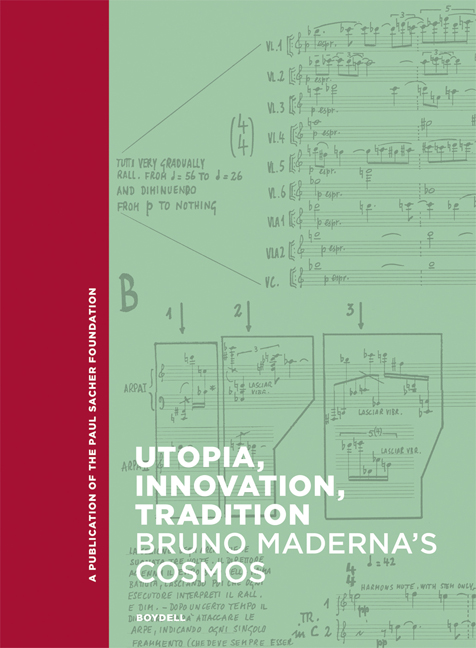Book contents
- Frontmatter
- Contents
- INTRODUCTION
- STAGING AND PERFORMING SOUNDS: A GLANCE THROUGH THE LAST THEATRICAL WORK
- BUILDING SOUNDS: THE COMPOSER
- CREATING SOUND: THE MUSIC BEYOND/WITHOUT THE STAGE
- REINVENTING SOUNDS: DIALOGUES WITH MUSIC OF EVERY EPOCH AND STYLE
- ACROSS BORDERS: THE CONDUCTOR AND THE INTERPRETER
- SEARCHING FOR ROOTS: THE DEVELOPMENT OF A STYLE
- STAGING AND PERFORMING TEXTS: A GLANCE THROUGH EARLY DRAMATURGICAL AND VOCAL WORKS
- Chronology Of Bruno Maderna’s Works
- Selected Bibliography
- Index
Bruno Maderna and His Arrangements
Published online by Cambridge University Press: 17 January 2024
- Frontmatter
- Contents
- INTRODUCTION
- STAGING AND PERFORMING SOUNDS: A GLANCE THROUGH THE LAST THEATRICAL WORK
- BUILDING SOUNDS: THE COMPOSER
- CREATING SOUND: THE MUSIC BEYOND/WITHOUT THE STAGE
- REINVENTING SOUNDS: DIALOGUES WITH MUSIC OF EVERY EPOCH AND STYLE
- ACROSS BORDERS: THE CONDUCTOR AND THE INTERPRETER
- SEARCHING FOR ROOTS: THE DEVELOPMENT OF A STYLE
- STAGING AND PERFORMING TEXTS: A GLANCE THROUGH EARLY DRAMATURGICAL AND VOCAL WORKS
- Chronology Of Bruno Maderna’s Works
- Selected Bibliography
- Index
Summary
In the early 1960s, Maderna produced a large number of arrangements to be broadcast on radio and recorded on albums, indirectly becoming part of a cultural movement intent on renewing the Italian popular music scene. This important arranging experience evolved out of two occasions that had to do with the main media of popular music, that is, radio and records. In 1960 he took part in the launch of a radio musical program entitled Arcidiapason, and a few years later, in 1964, he recorded two LPs dedicated to Kurt Weill's songs, performed by Laura Betti. Maderna's temporary foray into the world of popular music coincided with a period of fervent musical activity and multiple commitments and projects. These include the composition of Don Perlimplin, the writing of various pieces that were later merged into the Hyperion cycle, intense activity as a conductor, collaboration with several radio productions, the creation of a number of compositions for the theater, and his experiences in the field of electronic experimentation, conducted at the RAI's Studio di Fonologia in Milan.
It is not surprising to find that Maderna, one of the leading composers of the European musical avant-garde, was quite familiar with the world of song, or so-called “light” music. Entertainment music had been part of Maderna's biographical horizon since childhood. Jazz music (in its various forms), popular music, and hit songs were in fact the repertoires played by his father's band, “The Happy Grossato Company – Original Jazz Band.” At the age of ten, Maderna had for a short time been the band's main performer as violinist and enfant prodige. Throughout his working life as a composer – from the jazz style he used in his first radio drama Il mio cuore e nel Sud (1949) to the embedded quotes of Satyricon (1972–73) – the traces of this link with popular or jazz culture are easy to see. In several works one can even observe a genuine act of “mediation” between languages whose different origins and rules make them apparently irreconcilable.
- Type
- Chapter
- Information
- Utopia, Innovation, TraditionBruno Maderna's Cosmos, pp. 245 - 274Publisher: Boydell & BrewerPrint publication year: 2023

